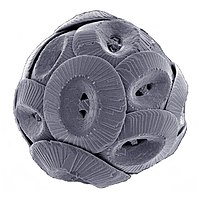
Photo from wikipedia
As an environmental nuisance, Ulva prolifera green tides have occurred annually in the southern Yellow Sea since 2007. While it is expected that high levels of biological activity during these… Click to show full abstract
As an environmental nuisance, Ulva prolifera green tides have occurred annually in the southern Yellow Sea since 2007. While it is expected that high levels of biological activity during these blooms can alter seawater carbonate chemistry, there has been little research on the responses of marine carbonate system to green tides. Here, the effects of the bloom on the carbonate system were examined on three cruises in June, July, and September, corresponding to the early-, late-, and after-bloom periods of the U. prolifera bloom in Qingdao coastal waters in 2018. Among these three stages, the pH (National Bureau of Standards scale), dissolved inorganic carbon (DIC), total alkalinity (TA), and partial pressure of CO2 (pCO2) were all affected by bloom, with the highest pH and lowest DIC and TA concentrations of the surface seawater occurring at the late-bloom stage. While pCO2 continuously increased from the beginning to the end of the bloom. TA increased by ∼40 μmol kg-1 between the early- and after-bloom periods likely due to the shifts in the carbonate system equilibrium caused by increased CO32- concentrations and the organic matter released by U. prolifera during decomposition. Compared to nearby areas with no U. prolifera bloom, the green tide, along with increasing temperature, reduced the pH and DIC but increased the TA and pCO2. This large-scale bloom also turned the coastal waters from being an atmospheric CO2 sink to a strong source, with the estimation of air-sea CO2 fluxes about 1.69 ± 1.70, 2.28 ± 1.16, and 7.44 ± 5.84 mmol m-2 d-1 during the early-, late-, and after-bloom periods, respectively. This bloom event also promoted the formation of CaCO3 and was an important source of low molecular weight organic acids. These new findings provide nuances for the current conversations on the role of biological processes in modulating marine carbonate system and the contribution of organic matter to alkalinity.
Journal Title: Harmful algae
Year Published: 2021
Link to full text (if available)
Share on Social Media: Sign Up to like & get
recommendations!